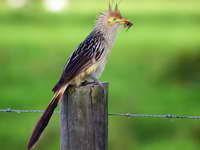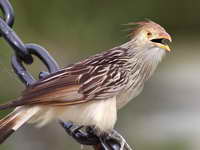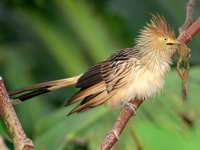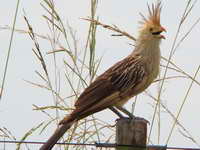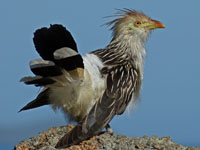The cuckoo family Cuculidae contains six subfamilies. The first three listed below are found in the New world, while the remaining three are found in the Old World.
* Coccyzinae – New World Cuckoos
* Neomorphinae – New World Ground Cuckoos
* Crotophaginae – Anis
* Cuculinae – Old World Cuckoos
* Phaenicophaeinae – Malkohas and Couas
* Centropodinae – Coucals
This article is about the Crotophaginae subfamily which contains the anis and also the guiri cuckoo. The three anis plus the guiri cuckoo make a totoal of 4 species in this small subfamily. None of these species are brood parastic and all are gregarious.
The three ani species live in the tropical Americas. The anis are not brood parasites, but nest communally, the cup nest being built by several pairs in a tree. A number of females lay their eggs in the nest and then share incubation and feeding. Their flight is weak and wobbly, but they run well, and usually feed on the ground. These are very gregarious species, always found in noisy groups. Anis feed on termites, large insects, and even lizards and frogs.
Th guiri cuckoo is also gregarious, but less so than the anis. It will feed in often mixed flocks, often with anis. Its diet is similar to the anis, but even more vafied including eggs and small birds. It does not nest communally. It is found in South merica.
The cuckoo family Cuculidae
The cuckoo family Cuculidae is the only family of the order Cuculiformes. The family is represented on all continents except Antarctica. Most species reside in tropical or subtropical environments. Those in temperate locations migrate to avoid cool or cold winters. In addition to cuckoos, the family Cuculidae also includes the roadrunners, koels, malkohas, couas, coucals and anis. The coucals and anis are sometimes separated as distinct families. The cuckoos are generally medium sized slender birds. The majority are of the cuculidae family are arboreal, with a sizeable minority that is terrestrial.
Cuckoos are medium sized birds that range in size from 15-63 cm. There is generally little sexual dimorphism in size, but where it exists, it can be either the male or the female that is larger, depending on the genera. There are two basic body forms, arboreal species which are slender and terrestrial species which are more heavy set and have stronger legs. Almost all species have long tails which are used for steering in terrestrial species and as a rudder during flight in the arboreal species.
Many species are brood parasites, laying their eggs in the nests of other species, but the majority of species raise their own young. The brood parasitic birds usually only parasitize a single host species or a small group of closely related host species. They tend to remove a host egg when they lay one of their own in a nest. This both prevents the host species from realizing their nest has been parasitized and reduces food competition for the parasitic nestling once it hatches. Some brood parasites will eliminate all their nest-mates shortly after hatching. If the host removes a parasitic egg or chick, the adult parasitic birds may retaliate by destroying the nest.
There has been an evolutionary arms race between the cuckoos that leave their eggs in other nests, and the hosts that get these unwanted presents. The cuckoos have evolved to be able to lay their eggs faster than most other species and the eggs need less incubation time before hatching. These eggs often resemble the host eggs to prevent detection of an invader egg. The drongo-cuckoos resemble their host. Some hosts have evolve to be social so the colony can be on the lookout for an invader trying to deposit an egg. Others have more than one brood of chicks per year so there will be replacements for any losses due to cuckoos.
Cuckoos feed on insects, small animals, seeds, and fruit. For many cuckoo species, caterpillars are their favorite food; even hairy caterpillars that are avoided by most other birds. Cuckoos can consume hairy caterpillars because of their ability to shed their abdominal lining and get rid of the hairs via a pellet. Another favorite food of many cuckoos are grasshoppers. We may find it repugnant that some cuckooos are brood parasitic and they or their offspring even kill the host's chicks, but on the plus side cuckoos help prevent plagues of caterpillars and grasshoppers!
Almost all cuckoos are shy which can make them a challenge to observe and photograph. Consistent with this behavior, they are not colonial breeders. These traits may be have their roots in their brood parasitic behavior. Stealth is a good characteristic if you want to sneak an egg into a host's nest.
Genus Crotophaga* Coccyzinae – New World Cuckoos
* Neomorphinae – New World Ground Cuckoos
* Crotophaginae – Anis
* Cuculinae – Old World Cuckoos
* Phaenicophaeinae – Malkohas and Couas
* Centropodinae – Coucals
This article is about the Crotophaginae subfamily which contains the anis and also the guiri cuckoo. The three anis plus the guiri cuckoo make a totoal of 4 species in this small subfamily. None of these species are brood parastic and all are gregarious.
The three ani species live in the tropical Americas. The anis are not brood parasites, but nest communally, the cup nest being built by several pairs in a tree. A number of females lay their eggs in the nest and then share incubation and feeding. Their flight is weak and wobbly, but they run well, and usually feed on the ground. These are very gregarious species, always found in noisy groups. Anis feed on termites, large insects, and even lizards and frogs.
Th guiri cuckoo is also gregarious, but less so than the anis. It will feed in often mixed flocks, often with anis. Its diet is similar to the anis, but even more vafied including eggs and small birds. It does not nest communally. It is found in South merica.
The cuckoo family Cuculidae
The cuckoo family Cuculidae is the only family of the order Cuculiformes. The family is represented on all continents except Antarctica. Most species reside in tropical or subtropical environments. Those in temperate locations migrate to avoid cool or cold winters. In addition to cuckoos, the family Cuculidae also includes the roadrunners, koels, malkohas, couas, coucals and anis. The coucals and anis are sometimes separated as distinct families. The cuckoos are generally medium sized slender birds. The majority are of the cuculidae family are arboreal, with a sizeable minority that is terrestrial.
Cuckoos are medium sized birds that range in size from 15-63 cm. There is generally little sexual dimorphism in size, but where it exists, it can be either the male or the female that is larger, depending on the genera. There are two basic body forms, arboreal species which are slender and terrestrial species which are more heavy set and have stronger legs. Almost all species have long tails which are used for steering in terrestrial species and as a rudder during flight in the arboreal species.
Many species are brood parasites, laying their eggs in the nests of other species, but the majority of species raise their own young. The brood parasitic birds usually only parasitize a single host species or a small group of closely related host species. They tend to remove a host egg when they lay one of their own in a nest. This both prevents the host species from realizing their nest has been parasitized and reduces food competition for the parasitic nestling once it hatches. Some brood parasites will eliminate all their nest-mates shortly after hatching. If the host removes a parasitic egg or chick, the adult parasitic birds may retaliate by destroying the nest.
There has been an evolutionary arms race between the cuckoos that leave their eggs in other nests, and the hosts that get these unwanted presents. The cuckoos have evolved to be able to lay their eggs faster than most other species and the eggs need less incubation time before hatching. These eggs often resemble the host eggs to prevent detection of an invader egg. The drongo-cuckoos resemble their host. Some hosts have evolve to be social so the colony can be on the lookout for an invader trying to deposit an egg. Others have more than one brood of chicks per year so there will be replacements for any losses due to cuckoos.
Cuckoos feed on insects, small animals, seeds, and fruit. For many cuckoo species, caterpillars are their favorite food; even hairy caterpillars that are avoided by most other birds. Cuckoos can consume hairy caterpillars because of their ability to shed their abdominal lining and get rid of the hairs via a pellet. Another favorite food of many cuckoos are grasshoppers. We may find it repugnant that some cuckooos are brood parasitic and they or their offspring even kill the host's chicks, but on the plus side cuckoos help prevent plagues of caterpillars and grasshoppers!
Almost all cuckoos are shy which can make them a challenge to observe and photograph. Consistent with this behavior, they are not colonial breeders. These traits may be have their roots in their brood parasitic behavior. Stealth is a good characteristic if you want to sneak an egg into a host's nest.
Cuckoo family members are zygodactyl: they have the 2 inner toes facing forward and 2 two outer toes facing to the rear.
Anis and Guiri Cuckoo
The three ani species live in the tropical Americas. The anis are not brood parasites, but nest communally, the cup nest being built by several pairs in a tree. A number of females lay their eggs in the nest and then share incubation and feeding.
Ani,_Greater Crotophaga major Found: Panama, South America
Description: The greater ani has black plumage with blue gloss. It has a massive ridged black bill and white eyes. Females may share the same nest, the incubation of the eggs, and feeding of the chicks. The similar groove-billed ani has black eyes.
Range: Panama, South America.
Habitat: Semi-open areas such as mangroves, pastures, swamps.
Diet: Large insects, frogs, lizards.
Conservation status: Least concern
Image by: 1) Dominic Sherony 2) Arthur Chapman 3) Dick Daniels - Soberania National Park, Panama 4) Nick Athanas - EcuadorRange: Panama, South America.
Habitat: Semi-open areas such as mangroves, pastures, swamps.
Diet: Large insects, frogs, lizards.
Conservation status: Least concern
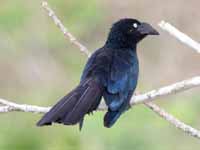
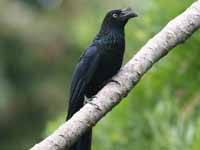

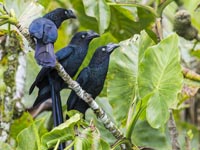
Ani,_Groove-billed Crotophaga sulcirostris Found: North America (Texas), Central and South America
Description: The groove-billed ani has a heavily grooved gray bill. It has black plumage and black eyes.
Range: Texas, Central and South America.
Habitat:
Habitat: Semi-open areas such as mangroves, pastures, swamps.
Diet: Insects, spiders, frogs, lizards. Similar to: * Greater Ani. Greater ani has white eye; groove-billed ani has black eyes. * Smooth-billed Ani. Groove-billed ani has narrow grooves in the bill; smooth-billed does not.
Conservation status: Least concern
Image by: 1) Hans Hillewaert - Costa Rica 2) Pablo Leautard - Mexico 3) Nick Athanas 4) Cephas - Costa RicaRange: Texas, Central and South America.
Habitat:
Habitat: Semi-open areas such as mangroves, pastures, swamps.
Diet: Insects, spiders, frogs, lizards. Similar to: * Greater Ani. Greater ani has white eye; groove-billed ani has black eyes. * Smooth-billed Ani. Groove-billed ani has narrow grooves in the bill; smooth-billed does not.
Conservation status: Least concern
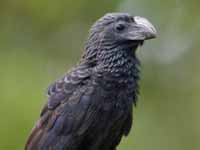
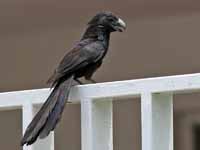
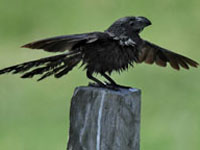
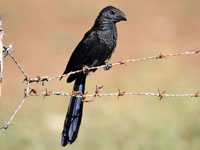
Ani,_Smooth-billed Crotophaga ani Found: North America (Florida), Central and South America
Description: The smooth-billed ani has a lightly grooved gray bill. It has black plumage and black eyes. The neck is shaggy. Females may share the same nest, the incubation of the eggs, and feeding of the chicks. The narrow and more prominent grooves in the bill of the groove-billed ani help to distinguish it from the smooth-billed ani.
Range: Florida, Central and South America.
Habitat: Open and semi-open country and areas under cultivation.
Diet: Large insects including trmites, frogs, lizards.
Conservation status: Least concern
Image by: 1) Dick Daniels - Royal Palm Reserve, Jamaica 2) Charles_J_Sharp 3) Ron_Knight 4) ) Nick Athanas - BrazilRange: Florida, Central and South America.
Habitat: Open and semi-open country and areas under cultivation.
Diet: Large insects including trmites, frogs, lizards.
Conservation status: Least concern
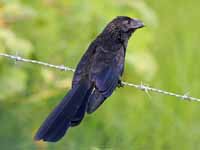
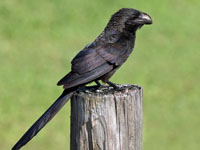
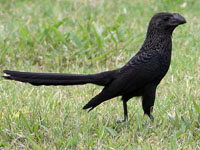
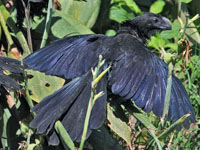
Genus Guira - 1 species
Cuckoo,_Guira Guira guira
Description: The guira cuckoo has dark brown upperparts streaked with white. The long tail is is also dark brown and has a white-tip. It has whitish-buff underparts. The guira cuckoo has a shaggy neck, an orange-rufous crest, bare yellow skin around the eye, andorange-yellow bill.
Range: South America in Argentina, Bolivia, Brazil, Paraguay, Uruguay.
Habitat: Open areas such as pastures and wetlands.
Diet: Insects, spiders, frogs, lizards, worms, snails, eggs, small birds.
Conservation status: Least concern
Image by: 1, 3)
Dario Sanches -
Brazil
2) dFaulder -
Buenos Aires, Argentina 4) Claudio Timm - Rio Grande do Sul, Brazil 5) Gustavo_Duran - Brazil Range: South America in Argentina, Bolivia, Brazil, Paraguay, Uruguay.
Habitat: Open areas such as pastures and wetlands.
Diet: Insects, spiders, frogs, lizards, worms, snails, eggs, small birds.
Conservation status: Least concern
